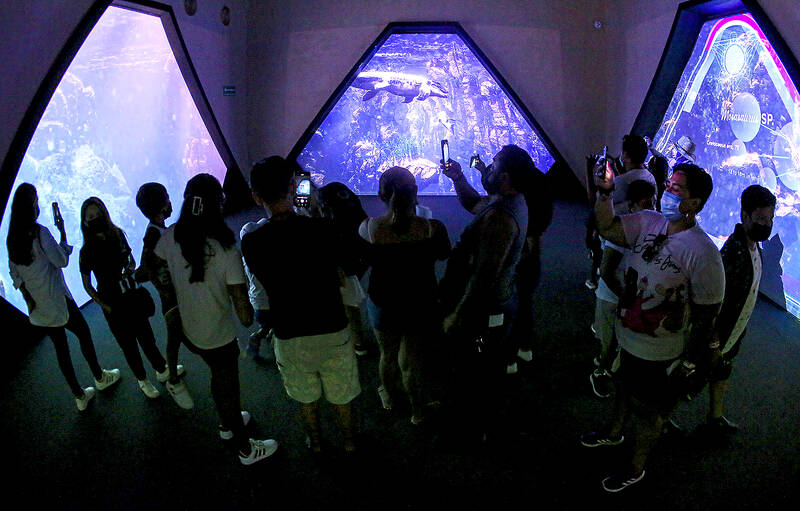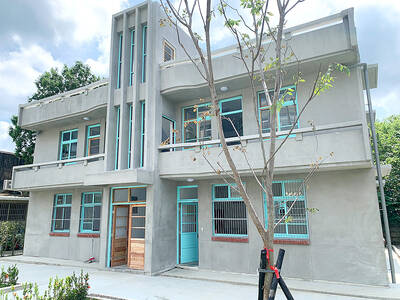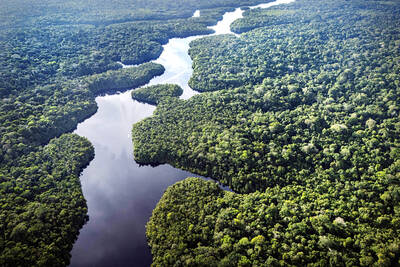Water covers three-quarters of the Earth’s surface and was crucial for the emergence of life, but its origins have remained a subject of active debate among scientists.
Now, a 4.6 billion-year-old rock that crashed on to a driveway in Gloucestershire, UK last year has provided some of the most compelling evidence to date that water arrived on Earth from asteroids in the outer solar system.
The Winchcombe meteorite, one of the “most pristine” available for analysis, offered scientists “a tantalizing glimpse back through time to the original composition of the solar system 4.6 billion years-ago,” said Ashley King, a research fellow at the Natural History Museum in London and author of a new paper on the space rock.

Photo: EPA-EFE
A prevailing theory is that the Earth was barren when it formed, as the inner region of the solar system was too hot for water to condense. The boundary of the region where ice could form in the early solar system is known as the frost line, and is located in the modern asteroid belt. Scientists think that water could have arrived to Earth later, raining down in icy meteoroids and large impacts.
However, there are competing theories, including that water was brought on comets — made mostly of ice and dust — or other similar bodies.
The latest analysis adds weight to the theory that asteroids made a leading contribution to water on Earth. Most of the Winchcombe meteorite was recovered just hours after its spectacular fireball lit up the skies over the UK in February last year during lockdown. One of the largest pieces was discovered on the driveway of the Wilcock family home, and a few smaller pieces were found in nearby gardens.
It is the first-ever carbonaceous chondrite meteorite — the oldest class of meteorites, which contain materials present during the formation of the solar system — to have been found in the UK. Crucially, it was collected within hours of being detected, before any rainfall, and analyzed almost immediately, making it a rare uncontaminated specimen.
The incoming meteorite was also recorded by 16 dedicated meteor cameras, and numerous doorbell and dashcam videos, meaning that scientists could produce an accurate trajectory of where it came from in the solar system. By contrast, most of the 70,000 known meteorites have been found without their impact being recorded — in some cases millions of years after they landed.
“They’re just random rocks that have come to us from space,” King said.
The analysis, published in the journal Science Advances, concludes that the meteorite originated from an asteroid body somewhere near Jupiter. The research also found that the ratio of hydrogen isotopes in the water closely resembled the composition of water on Earth.
“Meteorites like Winchcombe are a pretty good match [to] the water in the Earth’s oceans and suggests asteroids were the main source of water,” said King.
Extracts from the Winchcombe meteorite also contain extraterrestrial amino acids — prebiotic molecules that are fundamental building blocks for the origin of life.
As the composition of the Winchcombe meteorite is so pristinely preserved, the analysis suggests that similar asteroids have played a significant role in delivering the ingredients needed to kickstart oceans and life on early Earth.

June 2 to June 8 Taiwan’s woodcutters believe that if they see even one speck of red in their cooked rice, no matter how small, an accident is going to happen. Peng Chin-tian (彭錦田) swears that this has proven to be true at every stop during his decades-long career in the logging industry. Along with mining, timber harvesting was once considered the most dangerous profession in Taiwan. Not only were mishaps common during all stages of processing, it was difficult to transport the injured to get medical treatment. Many died during the arduous journey. Peng recounts some of his accidents in

“Why does Taiwan identity decline?”a group of researchers lead by University of Nevada political scientist Austin Wang (王宏恩) asked in a recent paper. After all, it is not difficult to explain the rise in Taiwanese identity after the early 1990s. But no model predicted its decline during the 2016-2018 period, they say. After testing various alternative explanations, Wang et al argue that the fall-off in Taiwanese identity during that period is related to voter hedging based on the performance of the Democratic Progressive Party (DPP). Since the DPP is perceived as the guardian of Taiwan identity, when it performs well,

A short walk beneath the dense Amazon canopy, the forest abruptly opens up. Fallen logs are rotting, the trees grow sparser and the temperature rises in places sunlight hits the ground. This is what 24 years of severe drought looks like in the world’s largest rainforest. But this patch of degraded forest, about the size of a soccer field, is a scientific experiment. Launched in 2000 by Brazilian and British scientists, Esecaflor — short for “Forest Drought Study Project” in Portuguese — set out to simulate a future in which the changing climate could deplete the Amazon of rainfall. It is

The Taiwan People’s Party (TPP) on May 18 held a rally in Taichung to mark the anniversary of President William Lai’s (賴清德) inauguration on May 20. The title of the rally could be loosely translated to “May 18 recall fraudulent goods” (518退貨ㄌㄨㄚˋ!). Unlike in English, where the terms are the same, “recall” (退貨) in this context refers to product recalls due to damaged, defective or fraudulent merchandise, not the political recalls (罷免) currently dominating the headlines. I attended the rally to determine if the impression was correct that the TPP under party Chairman Huang Kuo-Chang (黃國昌) had little of a